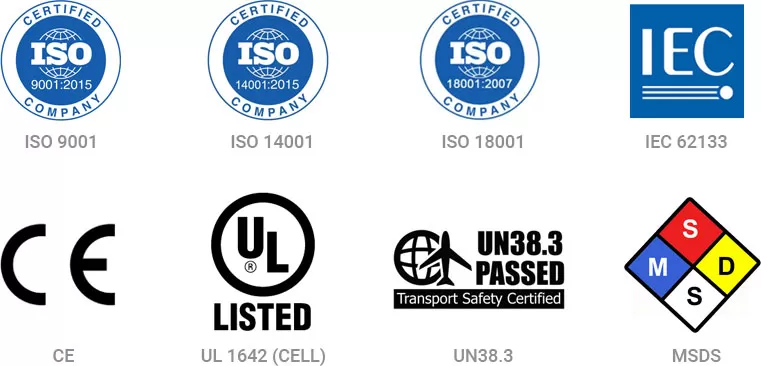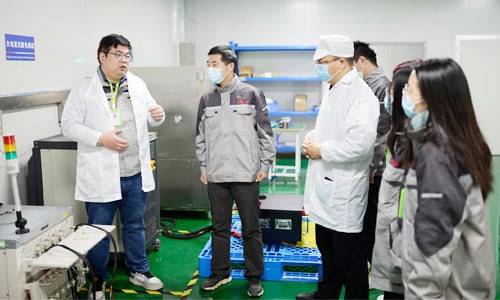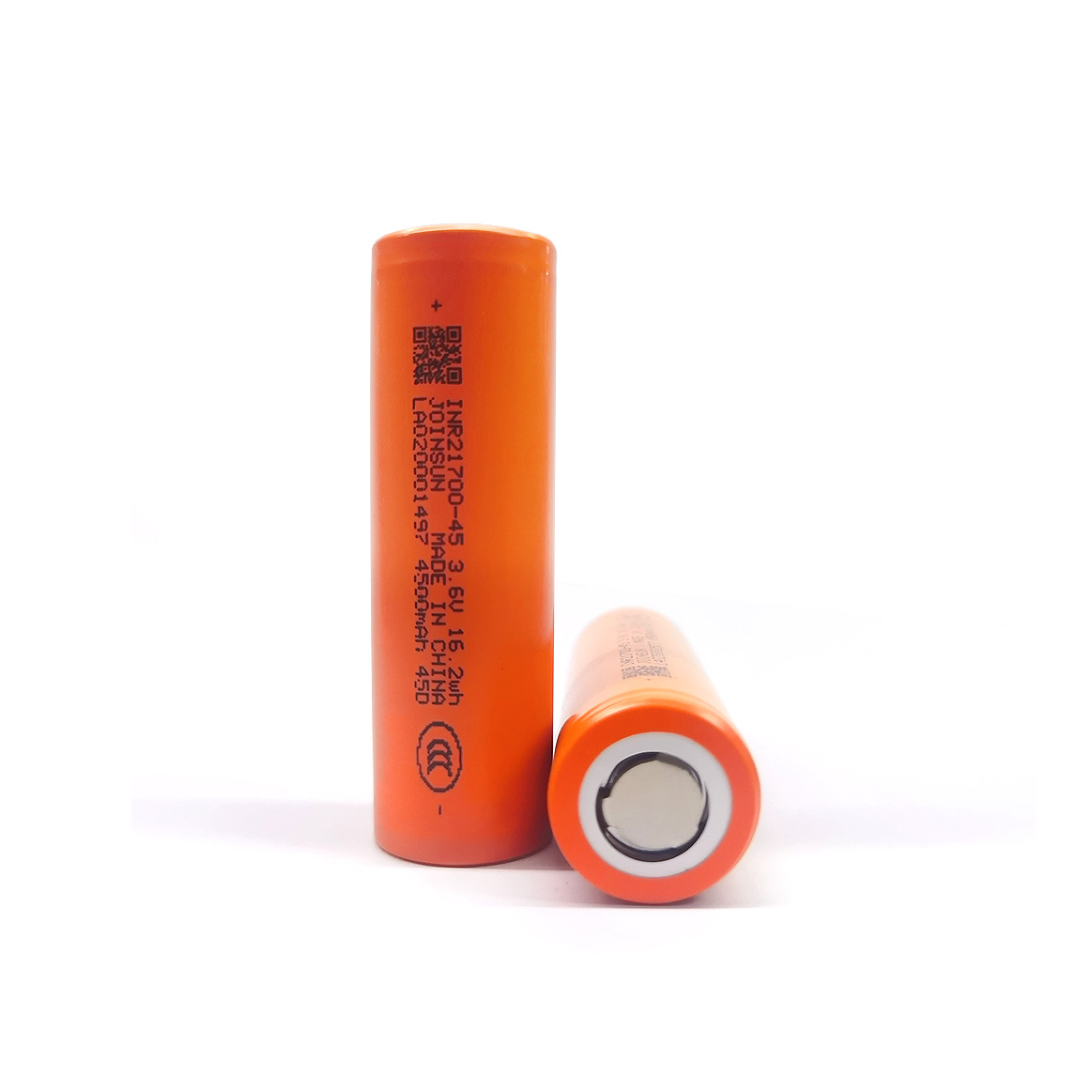Product Cateogries
Lithium Battery Cells

Redway Lithium Battery Pack Factory OEM and ODM 24V, 36V, 48V, 60V, 72V, and 80V lithium batteries are compatible with various electric pallet jacks and forklifts. They are designed for use with brands such as Toyota, CAT, Linde, Crown, Heli, Yale, Jungheinrich, and more.
All Redway Products Come with:

DIDN’ T FIND WHAT YOU WERE LOOKING FOR?
CUSTOM BATTERY SOLUTIONS
Redway Battery specializes in providing a diverse selection of battery sizes and configurations to cater to a wide range of applications. Whether you need standard battery options or have unique power requirements, our team of experienced engineers is here to assist you throughout the entire process of designing, developing, testing, and manufacturing custom battery solutions tailored to your specific needs. Feel free to reach out to us today to learn more about our comprehensive range of battery solutions and how we can create a customized solution for you.
DEDICATED FACTORY SUPPORT
Redway Battery is a renowned lithium-ion battery supplier and manufacturer located in China. We specialize in delivering OEM and ODM lithium batteries, catering to potential clients and customers.
By leveraging our combined domestic and international manufacturing capabilities, we are able to produce a diverse range of products that incorporate various cutting-edge technologies, offer flexible pricing options, and ensure timely delivery.
We continually strive to provide high-quality lithium-ion batteries that meet the demands of today’s market.
LEARN BATTERY KNOWLEDGE
At Redway Battery, our team of battery experts is dedicated to sharing comprehensive knowledge about new energy technologies. We are passionate about customizing batteries for a wide range of electronic devices, offering tailored battery solutions, and developing specialized battery solutions. We take pride in providing the most professional and up-to-date information regarding batteries. Our expertise covers a wide range of topics, including battery knowledge, industry news, company updates, informative guides, and more. By staying informed with us, you can access the latest insights and practical information on battery technologies and their applications. Stay connected with us to explore the world of batteries and unlock valuable knowledge and resources.

DOWNLOAD REDWAY PRODUCT BROCHURE AND SPEC
REDWAY PROMISE

QUALITY
6000 TIMES CYCLES
5 YEARS WARRANTY
10 YEARS DESIGN LIFE

CERTIFICATION
ISO9001,ISO14001, OHSAS18001, CE, CB, UL, KC, FCC, BIS, IEC62133.

SERVICES
EXW, FOB, DAP, DDP OPTIONAL T/T, L/C OPTIONAL
Related Knowledge
How to switch to lithium batteries in golf cart?
To switch to lithium batteries in a golf cart, follow these steps: 1. Choose the appropriate battery voltage and capacity. 2. Disconnect the old batteries and remove any mounting straps. 3. Install the new lithium batteries in the golf cart. Ensure proper installation procedures and consider manufacturer instructions for best results.
- Choose the right battery specifications: Determine the appropriate voltage and capacity for your new lithium batteries. Consider factors such as the golf cart’s power requirements and desired range.
- Disconnect and remove old batteries: Safely disconnect the existing lead acid batteries from the golf cart. Remove any mounting straps or brackets that secure them in place.
- Install lithium batteries: Carefully install the new lithium batteries in the golf cart, ensuring proper alignment and connection. Follow the manufacturer’s instructions for installation, as specific steps may vary.
- Verify proper installation: Double-check all connections and ensure the batteries are securely in place. Test the golf cart to ensure it is functioning correctly with the new lithium batteries.
Do you add water to lithium golf cart batteries?
Lithium golf cart batteries do not require the addition of water. Unlike traditional lead-acid batteries, lithium batteries have a different design and do not rely on the same electrolyte system. Therefore, there is no need to add water to lithium golf cart batteries, making them low-maintenance and hassle-free.
- No water required: Unlike traditional lead-acid batteries, lithium golf cart batteries do not require the addition of water. This is because lithium batteries have a different design and chemistry that eliminates the need for regular water maintenance.
- Different electrolyte system: Lead-acid batteries rely on an electrolyte solution that can evaporate over time, leading to a decrease in electrolyte levels. Adding distilled water helps replenish these levels. In contrast, lithium batteries utilize a different electrolyte system that does not require regular water replenishment.
- Low-maintenance advantage: The absence of water maintenance is one of the advantages of lithium golf cart batteries. Owners can enjoy the convenience of not having to monitor water levels or perform regular water additions, saving time and effort.
Do you leave lithium golf cart batteries plugged in?
The decision to leave lithium golf cart batteries plugged in depends on the manufacturer’s recommendations. Club Car advises keeping the golf cart plugged in during extended storage, while E-Z-GO suggests leaving the charger unplugged in similar circumstances. Yamaha suggests completely unplugging the golf cart batteries until they discharge. It is crucial to consult the specific guidelines provided by the golf cart manufacturer for the best practice regarding leaving lithium golf cart batteries plugged in.
- Club Car’s recommendation: Club Car advises keeping the golf cart plugged in during extended storage. This practice ensures that the batteries remain charged and ready for use when needed.
- E-Z-GO’s suggestion: On the other hand, E-Z-GO recommends leaving the charger unplugged in similar circumstances. This approach may be aimed at minimizing the potential for overcharging or maintaining a specific charging pattern.
- Yamaha’s approach: Yamaha suggests completely unplugging the golf cart batteries until they discharge. This approach allows the batteries to naturally reach a lower charge level during storage.
How to charge a lithium ion golf cart battery?
To charge a lithium-ion golf cart battery, follow these steps: 1. Use a high-quality charger designed for lithium-ion batteries. 2. Monitor the charging process to prevent overcharging. 3. Keep the battery and charging connections clean for optimal charging efficiency.
- Use a high-quality charger: It is crucial to use a charger specifically designed for lithium-ion batteries. These chargers are equipped with the necessary features to provide safe and efficient charging. Avoid using chargers that are not compatible with lithium-ion batteries, as they can lead to improper charging and potential damage.
- Monitor the charging process: While charging, it is important to monitor the battery’s charging progress. Lithium-ion batteries should not be overcharged, as it can lead to reduced battery life and performance. Keep an eye on the charging time and disconnect the charger once the battery reaches a full charge.
- Keep the battery and connections clean: Regularly clean the battery and charging connections to ensure optimal charging efficiency. Remove any dirt, debris, or corrosion that may affect the charging process. A clean and reliable connection between the charger and the battery is essential for efficient charging.
Do you need a different charger for lithium batteries golf cart?
To charge lithium batteries in a golf cart, you need a charger that’s compatible with LiFePO4 lithium batteries. Many lead-acid chargers are not suitable because they don’t provide the correct voltage output. The charger voltage should match the battery voltage or be lower, typically ranging from 14.2 to 14.6 volts. Using a charger that’s not compatible can result in improper charging and potential damage to the lithium batteries.
- Compatibility with LiFePO4 lithium batteries: Unlike lead-acid batteries, lithium batteries require a charger that’s compatible with their specific chemistry. Many lead-acid chargers are not suitable for lithium batteries because they don’t provide the correct voltage output. It is essential to use a charger that is designed to work with LiFePO4 lithium batteries.
- Voltage requirements: The charger voltage should match the battery voltage or be lower. For lithium batteries in golf carts, the recommended voltage range is typically between 14.2 to 14.6 volts. Using a charger with the wrong voltage output can result in improper charging, which may affect the performance and lifespan of the lithium batteries.
What is the proper way to charge a lithium-ion battery?
To charge a lithium-ion battery properly, use the charger provided by the device manufacturer or a compatible charger. Control the charging voltage, ensuring it is set below the maximum voltage, typically around 4.1 volts. The charge current can range from half of the battery’s capacity (c/2) to the battery’s full capacity (1C) for a duration of 2.5 to 3 hours. Monitor the charging process and stop charging when the battery is fully charged to prevent overcharging.
- Use the provided or compatible charger: It is highly recommended to use the charger provided by the device manufacturer or a compatible charger specifically designed for charging lithium-ion batteries. These chargers are designed to meet the specifications and requirements of lithium-ion batteries, ensuring safe and efficient charging.
- Control the charging voltage and current: When charging a lithium-ion battery, it is important to control the charging voltage and current. The charging voltage should be set below the maximum voltage, typically around 4.1 volts, to prevent overcharging. The charge current can range from half of the battery’s capacity (c/2) to the battery’s full capacity (1C) for a duration of 2.5 to 3 hours. This controlled charging process helps optimize the battery’s performance and prolong its lifespan.
- Monitor the charging process: During the charging process, it is essential to monitor the battery’s charging progress. Once the battery reaches its full charge, it is important to stop the charging process to prevent overcharging. Overcharging can lead to reduced battery life and potential safety risks. Regularly check the charging status to ensure timely disconnection from the charger when the battery is fully charged.
What is the cut off voltage for a 60V lithium ion battery?
The cut-off voltage for a 60V lithium-ion battery may vary based on the battery’s chemistry and application. To ensure optimal performance and prevent damage, it is essential to refer to the manufacturer’s specifications or guidelines for the specific battery. The recommended cut-off voltage should be followed during discharge to maintain the battery’s longevity and efficiency.
- Battery-specific cut-off voltage: The cut-off voltage for a 60V lithium-ion battery can vary depending on the specific battery chemistry and its intended application. Different lithium-ion battery chemistries may have different voltage thresholds to ensure safe operation and prevent damage.
- Manufacturer’s specifications: To determine the recommended cut-off voltage for a 60V lithium-ion battery, it is essential to refer to the manufacturer’s specifications or guidelines. These specifications provide valuable information about the optimal voltage range for discharge, ensuring the battery’s longevity and efficiency.
- Importance of following guidelines: Adhering to the recommended cut-off voltage during discharge is crucial for maintaining the overall health of the lithium-ion battery. Discharging the battery below the specified cut-off voltage can lead to irreversible damage, reduced performance, and a shorter lifespan.
What is the best voltage for LiFePO4?
The best voltage for LiFePO4 batteries can vary depending on the specific application and desired performance. In general, the recommended voltage range for LiFePO4 batteries during the bulk/absorb charging phase is between 14.2 and 14.6 volts. However, some sources suggest charging to a lower voltage, such as 14.0 volts, to optimize the battery’s lifespan. It is crucial to refer to the manufacturer’s recommendations and specific requirements for your LiFePO4 battery to ensure safe and efficient charging.
- Recommended voltage range: The recommended voltage range for LiFePO4 batteries during the bulk/absorb charging phase typically falls between 14.2 and 14.6 volts. This range helps ensure efficient charging and optimal battery performance.
- Alternative voltage options: Some sources suggest charging LiFePO4 batteries to a lower voltage, such as 14.0 volts, to enhance the battery’s lifespan. This approach aims to balance the charging process and reduce stress on the battery cells, potentially improving overall longevity.
- Manufacturer’s recommendations: To determine the best voltage for your LiFePO4 battery, it is crucial to refer to the manufacturer’s specifications and guidelines. Manufacturers provide valuable insights into the optimal voltage ranges and charging methods specific to their LiFePO4 battery models.
Should you keep LiFePO4 batteries fully charged?
Keeping LiFePO4 batteries fully charged for extended periods is not recommended to ensure their longevity. Although LiFePO4 batteries have a lower risk of thermal runaway, fully charging them and leaving them at 100% charge for prolonged periods can still lead to degradation. It is advisable to store LiFePO4 batteries at a lower state of charge, around 50% to 70%, for long-term storage or when not in use.
- Battery degradation risks: Keeping LiFePO4 batteries fully charged for extended periods can lead to battery degradation. Although LiFePO4 batteries have a lower risk of thermal runaway compared to other lithium-ion chemistries, fully charging them and leaving them at 100% charge can still contribute to reduced battery lifespan.
- Optimal state of charge for storage: To maintain the longevity of LiFePO4 batteries, it is advisable to store them at a lower state of charge, typically around 50% to 70%. This range helps minimize stress on the battery cells and mitigates the risk of degradation during periods of non-use or long-term storage.
- Long-term storage considerations: When storing LiFePO4 batteries for an extended duration, it is essential to periodically check and recharge them to prevent self-discharge. However, it is still recommended to store them at a lower state of charge, as fully charging them and leaving them idle for a long time can negatively impact their overall health.
What is the actual voltage of a 60V battery?
The actual voltage of a 60V battery can vary depending on factors such as battery chemistry, load conditions, and state of charge. A fully charged 60V battery typically has an actual voltage ranging from around 59.5 volts to 62.4 volts. However, it is crucial to consider that the actual voltage may fluctuate based on usage and other environmental factors.
- Voltage range: The actual voltage of a fully charged 60V battery can range from approximately 59.5 volts to 62.4 volts. This range accounts for variations in battery chemistry, load conditions, and other factors that influence voltage output.
- Battery chemistry and load conditions: Different battery chemistries and load conditions can affect the actual voltage of a 60V battery. Factors such as internal resistance, temperature, and discharge rate can impact the voltage output, resulting in variations from the nominal voltage.
- State of charge: The actual voltage of a 60V battery can also vary depending on its state of charge. As the battery discharges, the voltage gradually decreases. Therefore, the actual voltage will be lower when the battery is partially discharged compared to when it is fully charged.
How many LiFePO4 cells to make 72V?
To create a 72V LiFePO4 battery pack, you need to connect approximately 22.5 cells in series. Each LiFePO4 cell has a nominal voltage of 3.2 volts. By dividing the desired voltage (72 volts) by the nominal voltage of each cell (3.2 volts), you get the number of cells needed. In practice, you would connect either 22 or 23 cells in series to achieve a 72V battery pack.
- Calculation of cell requirement: To calculate the number of LiFePO4 cells needed for a 72V battery pack, divide the desired voltage (72V) by the nominal voltage of each cell (3.2V). The result is approximately 22.5 cells. However, since it is not practical to connect a fraction of a cell, you would typically connect either 22 or 23 cells in series.
- Considerations for cell configuration: When connecting LiFePO4 cells in series, it is essential to ensure that each cell has the same voltage rating and capacity. This helps maintain uniformity and balance within the battery pack, optimizing its performance and longevity.
- Safety precautions: When working with LiFePO4 cells, it is crucial to follow proper safety protocols, including handling the cells with care, using appropriate insulation materials, and implementing a suitable battery management system (BMS) to monitor and protect the battery pack.
What is the best setting for a LiFePO4 battery?
The best setting for a LiFePO4 battery involves a multi-stage charge profile. For a 4S LiFePO4 battery, it is recommended to use a charge voltage of 14.4V (3.6V per cell) and allow 30 minutes of absorption time to balance the lithium cells. Afterward, the voltage should be dropped to a float voltage of 13.6V. These settings help optimize the charging process and ensure the longevity of the LiFePO4 battery.
- Multi-stage charge profile: The best setting for a LiFePO4 battery involves a multi-stage charge profile. This profile typically includes three stages: bulk charging, absorption charging, and float charging.
- Charge voltage: The charge voltage is an important parameter to consider when setting up a LiFePO4 battery. It is generally recommended to use a charge voltage of 14.4V, which translates to 3.6V per cell for a 4S LiFePO4 battery. This voltage ensures efficient charging without causing overcharging or undercharging.
- Absorption time: Allowing an absorption time is essential to balance the lithium cells within the LiFePO4 battery. A recommended absorption time is around 30 minutes, which helps equalize the charge across all cells and optimize their performance.
- Float voltage: After the absorption stage, it is advisable to drop the voltage to a float voltage. A float voltage of 13.6V is commonly recommended for LiFePO4 batteries. This voltage level helps maintain the battery’s charge without overcharging it, ensuring its longevity.
How fast is 3000w 72V in mph?
A 3000W eBike can achieve speeds of up to 45-50 miles per hour (72-80 kilometers per hour). With its powerful motor, it offers a high-performance riding experience for those seeking speed and excitement on an electric bike.
- Power of a 3000W eBike: The 3000W rating refers to the motor power output of the eBike. A higher wattage generally translates to increased acceleration and top speed potential.
- Speed range: A 3000W eBike can reach speeds ranging from approximately 45 to 50 miles per hour (72 to 80 kilometers per hour). However, it is important to note that the actual speed achieved may vary depending on factors such as rider weight, terrain, and bike specifications.
- Factors influencing speed: The speed of a 3000W eBike can be influenced by several factors. Lighter riders may experience higher speeds compared to heavier riders. Additionally, riding on flat terrain or downhill can contribute to achieving the upper end of the speed range.
- Safety considerations: When riding a high-speed eBike, it is crucial to prioritize safety. Wearing appropriate safety gear, such as a helmet and protective clothing, and following local traffic regulations are essential for a safe and enjoyable riding experience.
What is the charging voltage of 72V LiFePO4?
The charging voltage of a 72V LiFePO4 battery depends on the cell configuration. Generally, LiFePO4 cells have a nominal charge voltage of around 3.2V per cell. Therefore, a 72V LiFePO4 battery would typically require approximately 22.5 cells. It is important to consult the manufacturer’s recommendations for the specific charging voltage and any additional considerations.
- Nominal charge voltage: LiFePO4 cells typically have a nominal charge voltage of around 3.2V per cell. This voltage represents the average voltage during the charging process and is a standard reference point for LiFePO4 batteries.
- Calculation for 72V LiFePO4: To determine the charging voltage for a 72V LiFePO4 battery, divide the total voltage (72V) by the nominal voltage per cell (3.2V). The result is approximately 22.5 cells. However, it is important to note that LiFePO4 cells are typically connected in series, and the actual number of cells used may vary based on the specific battery configuration.
- Manufacturer’s recommendations: It is crucial to consult the manufacturer’s recommendations for the specific charging voltage of a 72V LiFePO4 battery. Different manufacturers may have slight variations in their recommended charging voltages, taking into account factors such as cell chemistry, capacity, and safety considerations.
- Additional considerations: When charging a 72V LiFePO4 battery, it is important to ensure the charger used is compatible with the battery’s voltage and chemistry. Using a charger with the correct voltage range and charging algorithm helps optimize the charging process and ensures the longevity of the battery.


